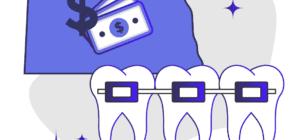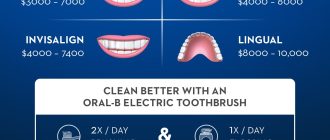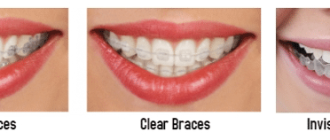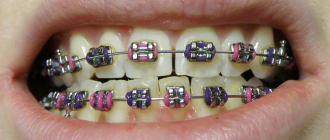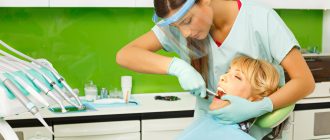The upper teeth are a prominent feature of our face; they define our smile and can noticeably enhance our appearance. For this reason it makes sense that many people look into the cost of realigning their upper teeth with braces. Experiencing crookedness or excessive spacing in the upper maxillary jaw is not uncommon. There are various explanations for having unsightly or abnormal upper teeth and also numerous reasons for seeking treatment. This page discusses the different options for treating top teeth problems and the associated costs involved.
What’s in the cost?
In adults, the upper teeth are positioned in the maxilla and extend from tooth number 1 which is the right third molar to number 16 (the upper left third molar). In children, the top teeth have a different numbering system starting at letter A (upper right second primary molar) to J (top left second primary molar). These teeth are an important aspect of proper bite and also crucial for providing a beautiful and attractive smile.
As to whether the upper teeth can be treated separately from the lower teeth, this can only be decided by a qualified dentist or orthodontist. If this is the case, then the costs will be slightly less than full braces, being approximately $3,000 to $7,600. On the other hand, if the patient is assessed as requiring full orthodontic treatment of both dental arches then the patient will not be saving much fees and charges even though the problems are being experienced with the upper teeth only. The typical cost for complete braces is $4,500 to $10,000.
Crowding or spacing
The main reason that adults seek treatment for their upper teeth is cosmetic because their teeth are either crooked or they have undue spaces between the front incisors (which are evident when they speak or smile). This can impact on a patient’s self-esteem and even perhaps their ability to speak or bite properly.
Crowding problems can result from a number of factors including if there was not enough space for the teeth whilst they were developing, if the teeth are extraordinarily large for the size of the dental arch or if the jaw is narrower than it typically should be. The costs of spacing out the upper teeth can range between $3,700 and $9,000, depending on whether lower teeth treatment is required as well. If the teeth are overly crowded the patient may also require removal of one or more teeth prior to braces treatment and this will add to the braces costs.
As for spacing there are various reasons why a patient would have gaps in the upper teeth. One reason is if the patient has missing teeth then other teeth may have drifted into the empty areas of the dental arch, creating uneven spacing. With this condition, braces can help to shift the position of the upper teeth in order to replace the missing teeth and the cost of doing so ranges between $4,800 and $9,400.
Another reason for disparities in the top teeth is where the patient has particularly small teeth in a standard sized jaw. This often results in large spaces between the front incisors. Braces for small upper teeth can cost in the vicinity of $3,900 to $8,900 to rectify spacing problems.
Correcting bite problems
Having irregular upper teeth can affect the patient’s bite in addition to spacing and crowding problems. There are various types of bite conditions which can be associated with upper teeth deformities and can affect the patient in numerous ways. Where the upper teeth rest inside or outside the lower teeth, this is referred to as cross-bite.
If the patient has developed a cross-bite from a young age, it can cause difficulties with chewing or biting and may even trigger the jaw to shift to one side as it grows. This condition may require jaw surgery in order to correct the problem in addition to braces, adding significant expense to the ordinary costs of getting braces for repairing upper teeth.
A deep overbite is a form of crossbite and occurs when the front teeth also caused the incisors to protrude significantly over the lower teeth. A serious overbite occurs where the front teeth bite into the lower gum in front of the lower teeth and/or where the lower incisors bite into the roof of the mouth. Correcting this problem may require surgery to the jaw and/or braces. The cost of correcting a deep overbite can be between $5,900 and $10,800.
Another bite problem associated with irregular upper teeth is an underbite, where the front lower teeth extend beyond the upper teeth. This type of deformity may or may not require surgery. Once again where surgery is needed to correct an underbite, this will increase the price of braces for upper teeth. Correcting an underbite with upper teeth braces can cost around $5,500 to $8,300.
Another less common type of bad bite is known as the open bite where there is a gap left between the upper and lower teeth when both meet or where the patient bites down. The problems involved with this condition include difficulty in biting off food with the front teeth and speech impediments. It may also lead to early wearing of the back teeth since there is too much pressure being placed on the molars when the patient chews. Correcting this problem may cost the patient more or less $5,500 to $10,600.
How can parents avoid paying for their child’s braces?
Often bite problems or irregularities of the upper teeth cannot be avoided by parents since these conditions are commonly inherited. However, where the child is born with normal top teeth and dental arch, there are ways parents can help maintain correct development of the upper jaw.
One way children can develop an irregular bite is through trauma where teeth are broken or knocked out and replaced. In this situation the new teeth may fuse with the child’s bone. This condition (known as ankylosis or abnormal root fusion) typically happens in growing children in these situations and may require braces or other orthodontic treatment in the future. Parents can help circumvent these problems by keeping their children safe and keeping them away from rough sports such as football.
Another way children can develop irregular upper teeth is by allowing them to prolong the thumb sucking or pacifier period. When a child continues to suck their thumb for a longer time than normal, this can cause the upper teeth to stick out further than the lower teeth (an overbite). By being vigilant with your child’s needs and removing the pacifier when necessary, this can significantly assist in normal development of healthy upper front teeth and evade the otherwise unnecessary costs of braces.
There are also other bad habits which children can develop which can hinder their teeth development process. One of these includes a tongue-thrusting action when the child swallows which can cause problems with teeth alignment and may require future orthodontic treatment. Often it is difficult for parents to diagnose these bad habits in children. This is where the particular expertise of an orthodontist can help. The American Association of Orthodontists advises that children receive orthodontic screening by no later than age 7. To avoid your child getting upper teeth abnormalities and excessive braces expenses you should have your child screened at an early age.
A different situation which can make children’s teeth lead to deformity is the premature loss of their baby teeth. However there is not much parents can do in terms of avoiding early loss of primary teeth other than keeping up the child’s regular dental hygiene and ensuring regular visits to a dentist for check-ups.
Assessing the cost
If you have uneven spacing, crowding or bite problems then deciding to get treatment is a big decision. If you are not experiencing any pain or discomfort and you have crowded teeth or gaps then you may wish to visit an orthodontist in any event to see whether your abnormalities will cause you problems in the future. Taking this preventative measure can help minimize the costs of treatment later on.
Crooked teeth or teeth with spacing can affect a person’s self-esteem and is worth the cost for many. As for more serious problems such as overbite and underbite, this can be quite costly to correct. However, the corrections are beneficial because teeth and jaw deformities can cause other problems such as not getting sufficient nutrition due to incorrect bite and also speech difficulties. If a child has bite problems, the associated speech difficulties may also require speech therapy which will add to the overall cost of treatment. In any case, getting proper orthodontic care for upper teeth will always cost the patient time and money, however in many situations it is a worthwhile investment.

